inflation pressure TOYOTA YARIS 2018 Owners Manual
[x] Cancel search | Manufacturer: TOYOTA, Model Year: 2018, Model line: YARIS, Model: TOYOTA YARIS 2018Pages: 632, PDF Size: 44.1 MB
Page 5 of 632
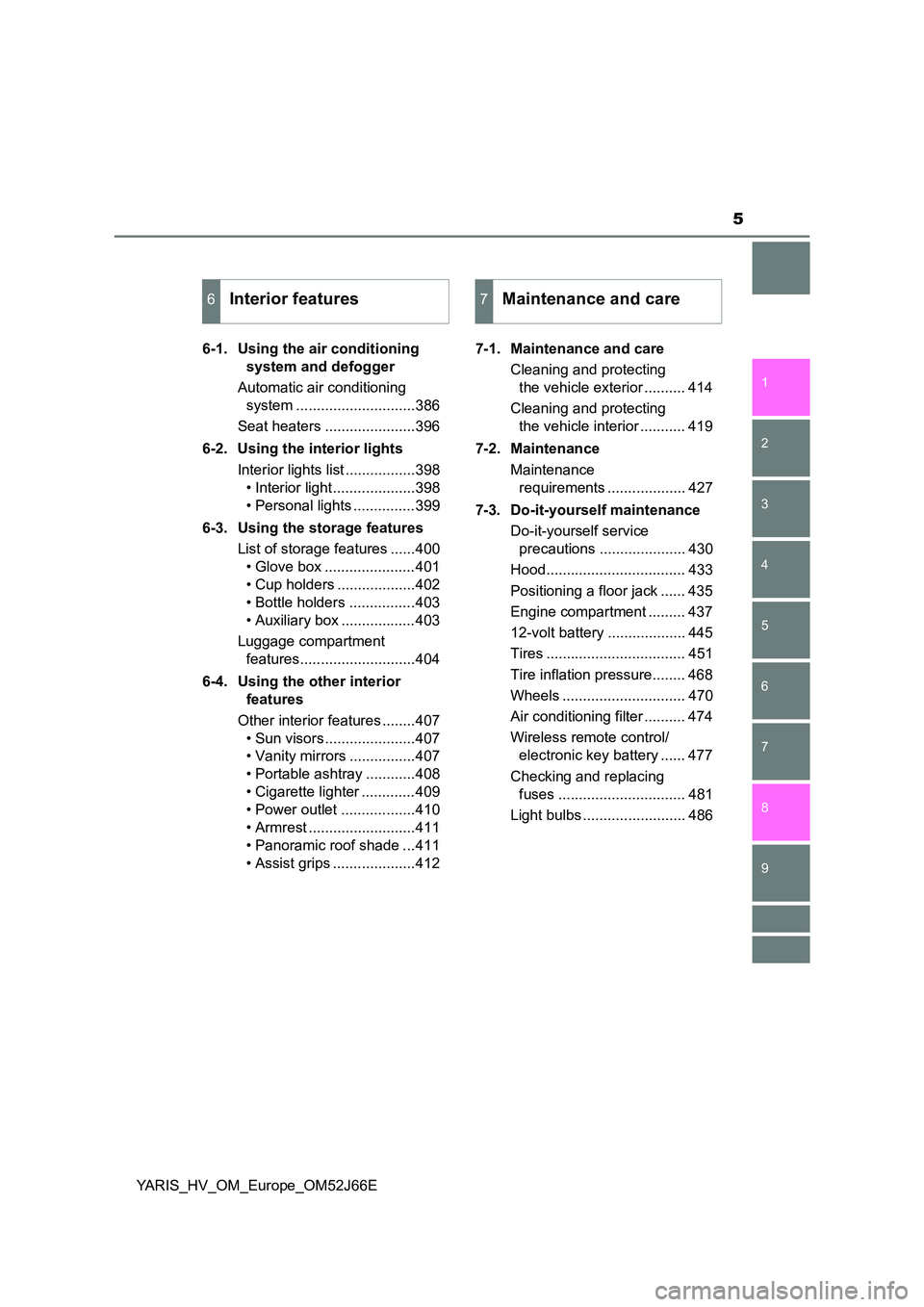
5
1
7
8
6
5
4
3
2
9
YARIS_HV_OM_Europe_OM52J66E
6-1. Using the air conditioning
system and defogger
Automatic air conditioning
system .............................386
Seat heaters ......................396
6-2. Using the interior lights
Interior lights list .................398
• Interior light ....................398
• Personal lights ...............399
6-3. Using the storage features
List of storage features ......400
• Glove box ......................401
• Cup holders ...................402
• Bottle holders ................403
• Auxiliary box ..................403
Luggage compartment
features............................404
6-4. Using the other interior
features
Other interior features ........407
• Sun visors ......................407
• Vanity mirrors ................407
• Portable ashtray ............408
• Cigarette lighter .............409
• Power outlet ..................410
• Armrest ..........................411
• Panoramic roof shade ...411
• Assist grips ....................412
7-1. Maintenance and care
Cleaning and protecting
the vehicle exterior .......... 414
Cleaning and protecting
the vehicle interior ........... 419
7-2. Maintenance
Maintenance
requirements ................... 427
7-3. Do-it-yourself maintenance
Do-it-yourself service
precautions ..................... 430
Hood.................................. 433
Positioning a floor jack ...... 435
Engine compartment ......... 437
12-volt battery ................... 445
Tires .................................. 451
Tire inflation pressure........ 468
Wheels .............................. 470
Air conditioning filter .......... 474
Wireless remote control/
electronic key battery ...... 477
Checking and replacing
fuses ............................... 481
Light bulbs ......................... 486
6Interior features7Maintenance and care
Page 15 of 632

15Pictorial index
YARIS_HV_OM_Europe_OM52J66E
Wipers. . . . . . . . . . . . . . . . . . . . . . . . . . . . . . . . . . . . . . . P. 246, 250
Precautions against winter season . . . . . . . . . . . . . . . . . . . . . P. 313
Precautions against car wash . . . . . . . . . . . . . . . . . . . . . . . . . P. 416
Fuel filler door . . . . . . . . . . . . . . . . . . . . . . . . . . . . . . . . . . . . P. 252
Refueling method . . . . . . . . . . . . . . . . . . . . . . . . . . . . . . . . . . P. 252
Fuel type/fuel tank capacity . . . . . . . . . . . . . . . . . . . . . . . . . . . P. 592
Tires . . . . . . . . . . . . . . . . . . . . . . . . . . . . . . . . . . . . . . . . . . . . P. 451
Tire size/inflation pressure . . . . . . . . . . . . . . . . . . . . . . . . . . . . P. 598
Winter tires/tire chain . . . . . . . . . . . . . . . . . . . . . . . . . . . . . . . . P. 313
Checking/rotation/tire pressure warning system*3 . . . . . . . . . P. 451
Coping with flat tires . . . . . . . . . . . . . . . . . . . . . . . . . . . . P. 537, 556
Hood . . . . . . . . . . . . . . . . . . . . . . . . . . . . . . . . . . . . . . . . . . . . P. 433
Opening . . . . . . . . . . . . . . . . . . . . . . . . . . . . . . . . . . . . . . . . . . P. 433
Engine oil . . . . . . . . . . . . . . . . . . . . . . . . . . . . . . . . . . . . . . . . . P. 593
Coping with overheat . . . . . . . . . . . . . . . . . . . . . . . . . . . . . . . . P. 581
Headlights/front position lights/daytime running lights/
front turn signal lights . . . . . . . . . . . . . . . . . . . . . . . . . P. 236, 238
Front fog lights*3. . . . . . . . . . . . . . . . . . . . . . . . . . . . . . . . . . P. 244
Side turn signal lights . . . . . . . . . . . . . . . . . . . . . . . . . . . . . . P. 236
Rear turn signal lights. . . . . . . . . . . . . . . . . . . . . . . . . . . . . . P. 236
Back-up lights/tail lights (LED type) . . . . . . . . . . . . . . . . . . P. 238
Shifting the shift lever to R. . . . . . . . . . . . . . . . . . . . . . . . . . . . P. 232
Stop/tail lights . . . . . . . . . . . . . . . . . . . . . . . . . . . . . . . . . . . . P. 238
Rear fog light . . . . . . . . . . . . . . . . . . . . . . . . . . . . . . . . . . . . . P. 244
License plate lights . . . . . . . . . . . . . . . . . . . . . . . . . . . . . . . . P. 238
4
5
6
7
Light bulbs of the exterior lights for driving
(Replacing method: P. 486, Watts: P. 600)
*1: Vehicles with a smart entry & start system
*2: Vehicles with monochrome display
*3: If equipped
8
9
10
11
12
13
14
15
Page 276 of 632
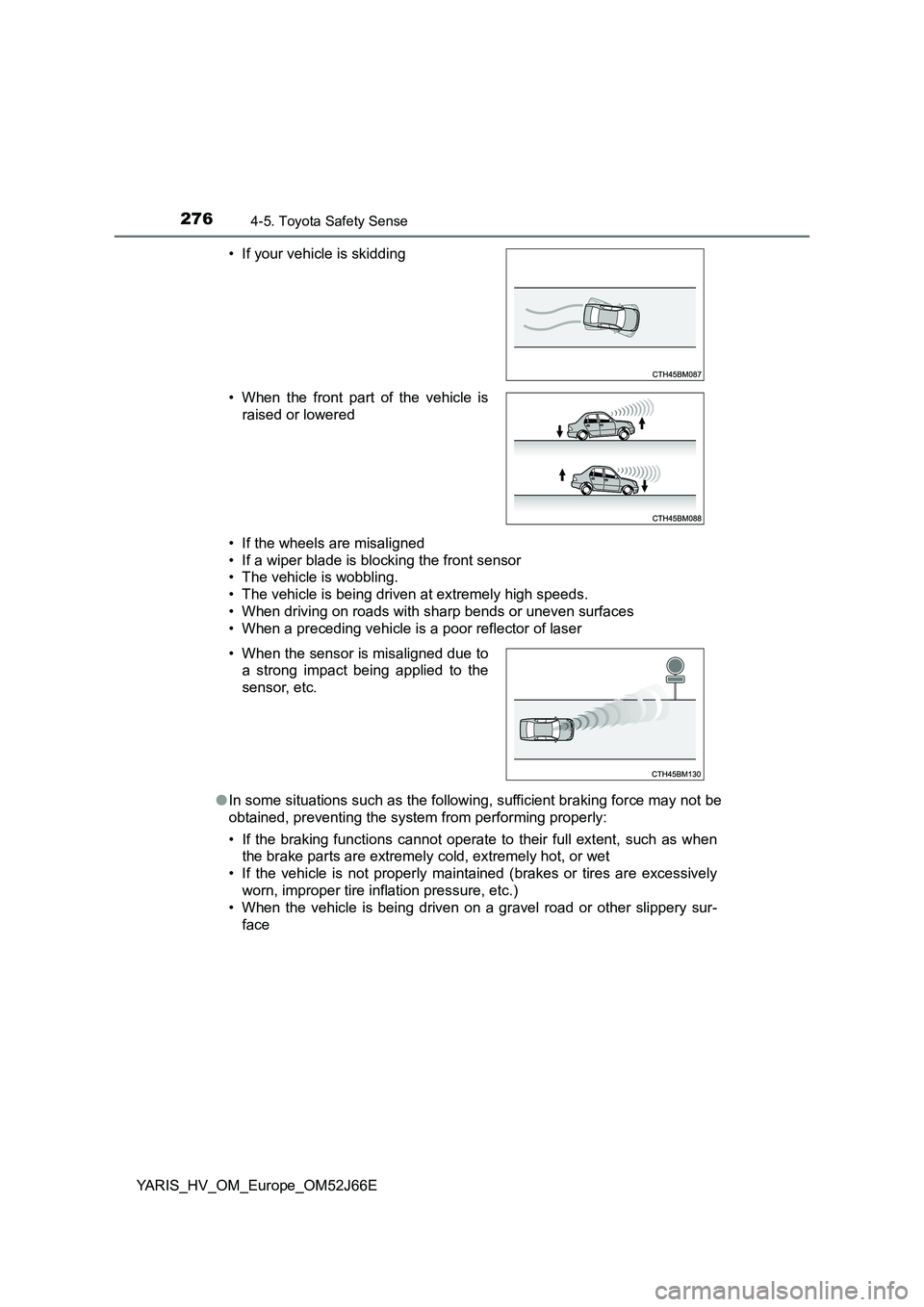
2764-5. Toyota Safety Sense
YARIS_HV_OM_Europe_OM52J66E
• If the wheels are misaligned
• If a wiper blade is blocking the front sensor
• The vehicle is wobbling.
• The vehicle is being driven at extremely high speeds.
• When driving on roads with sharp bends or uneven surfaces
• When a preceding vehicle is a poor reflector of laser
● In some situations such as the following, sufficient braking force may not be
obtained, preventing the system from performing properly:
• If the braking functions cannot operate to their full extent, such as when
the brake parts are extremely cold, extremely hot, or wet
• If the vehicle is not properly maintained (brakes or tires are excessively
worn, improper tire inflation pressure, etc.)
• When the vehicle is being driven on a gravel road or other slippery sur-
face
• If your vehicle is skidding
• When the front part of the vehicle is
raised or lowered
• When the sensor is misaligned due to
a strong impact being applied to the
sensor, etc.
Page 283 of 632

2834-5. Toyota Safety Sense
4
Driving
YARIS_HV_OM_Europe_OM52J66E
■Temporary cancelation of the LDA system functions
If any of the following occurs, the LDA system functions will be temporarily
canceled. The functions will resume after the necessary operating conditions
have returned.
● The turn signal lever is operated.
● The vehicle speed deviates from the operating range of the LDA system
functions.
● When the lane lines cannot be recognized while driving.
● When the lane departure warning sounds.
The lane departure warning function will not operate again for a several sec-
onds after it has been activated, even if the vehicle leaves the lane again.
■ The lane departure warning
Depending on the audio system sound level or air conditioning fan noise
while the audio system or air conditioning sy stem is in use, it may be difficult
to hear the warning sound.
■ After the vehicle has been parked in the sun
The LDA system may not be immediately available. When the temperature in
the cabin decreases and the temperature around the front sensor ( P. 257)
becomes suitable for its operation, the functions will begin to operate.
■ If there are lane markers on only one side of the vehicle
The lane departure warning will not oper ate for the side on which lane mark-
ers could not be recognized.
■ Conditions in which the function may not operate correctly
In the following situations, the front sensor may be unable to recognize lane
markers causing the lane departure warning function to operate incorrectly.
However, this does not indicate a malfunction.
● When driving through an area, such as a tollbooth, a crossing or before a
ticket checkpoint
● When driving on a sharp curve
● When lane markers are extremely narrow or extremely wide
● When the vehicle leans to one side an unusual amount due to a heavy load
or improper tire inflation pressure
● When the following distance between your vehicle and the vehicle ahead is
extremely short
Page 309 of 632
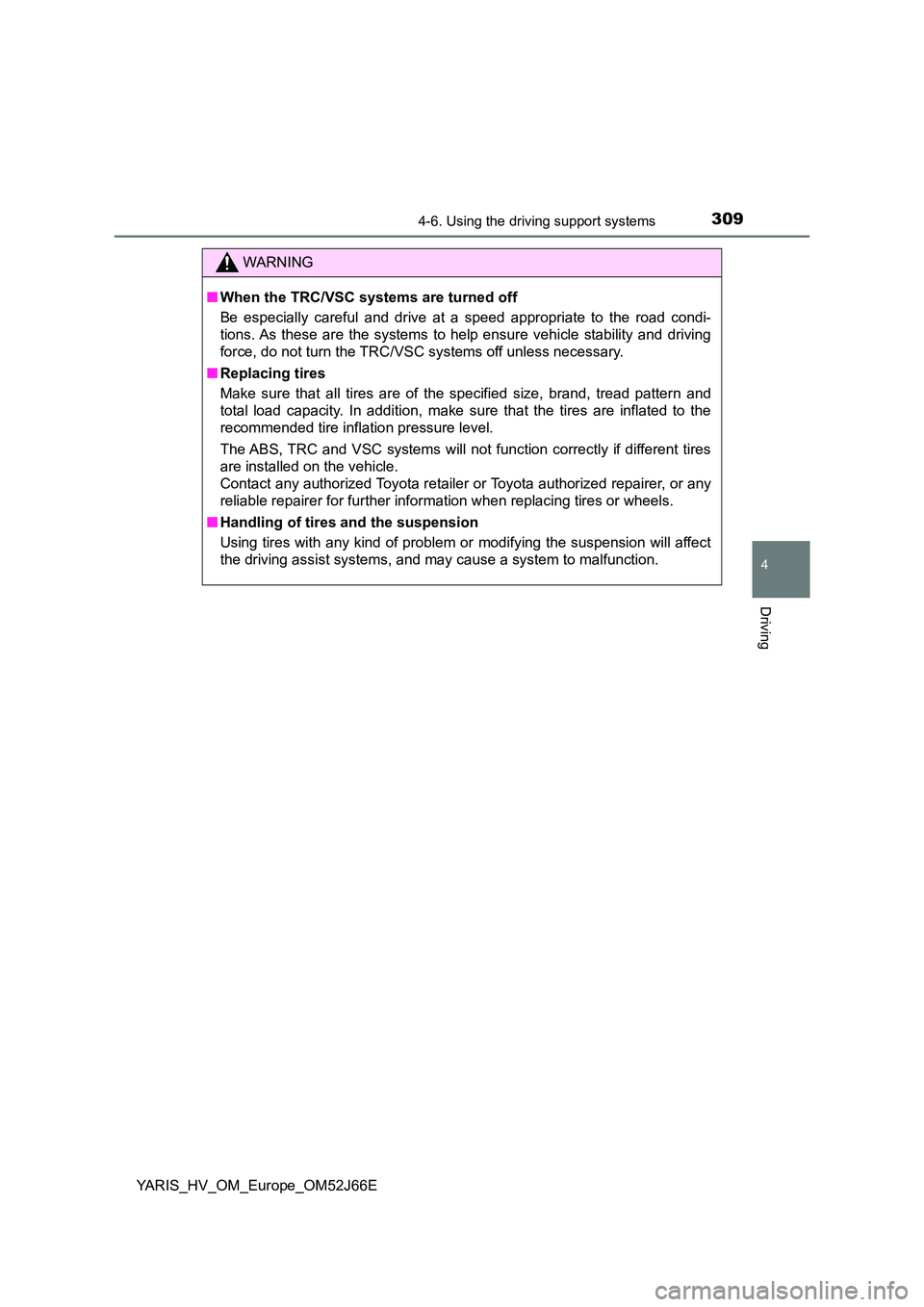
3094-6. Using the driving support systems
4
Driving
YARIS_HV_OM_Europe_OM52J66E
WARNING
■When the TRC/VSC systems are turned off
Be especially careful and drive at a speed appropriate to the road condi-
tions. As these are the systems to help ensure vehicle stability and driving
force, do not turn the TRC/VSC systems off unless necessary.
■ Replacing tires
Make sure that all tires are of the specified size, brand, tread pattern and
total load capacity. In addition, make sure that the tires are inflated to the
recommended tire inflation pressure level.
The ABS, TRC and VSC systems will not function correctly if different tires
are installed on the vehicle.
Contact any authorized Toyota retailer or Toyota authorized repairer, or any
reliable repairer for further information when replacing tires or wheels.
■ Handling of tires and the suspension
Using tires with any kind of problem or modifying the suspension will affect
the driving assist systems, and may cause a system to malfunction.
Page 312 of 632

3124-7. Driving tips
YARIS_HV_OM_Europe_OM52J66E
◆Air conditioning
Use the air conditioning only when necessary. Doing so can help
reduce excessive gasoline consumption.
In summer: When the ambient temperature is high, use the recircu-
lated air mode. Doing so will help to reduce the burden on the air
conditioning system and reduce fuel consumption as well.
In winter: Because the gasoline engine will not automatically cut out
until it and the interior of the vehicle are warm, it will consume fuel.
Also, fuel consumption can be improved by avoiding overuse of the
heater.
◆Checking tire inflation pressure
Make sure to check the tire inflation pressure frequently. Improper
tire inflation pressure can cause poor fuel economy.
Also, as snow tires can cause large amounts of friction, their use on
dry roads can lead to poor fuel economy. Use tires that are appro-
priate for the season.
◆Luggage
Carrying heavy luggage will lead to poor fuel economy. Avoid carry-
ing unnecessary luggage. Installing a large roof rack will also cause
poor fuel economy.
◆Warming up before driving
Since the gasoline engine starts up and cuts out automatically
when cold, warming up the engine is unnecessary. Moreover, fre-
quently driving short distances will cause the engine to repeatedly
warm up, which can lead to excess fuel consumption.
Page 413 of 632
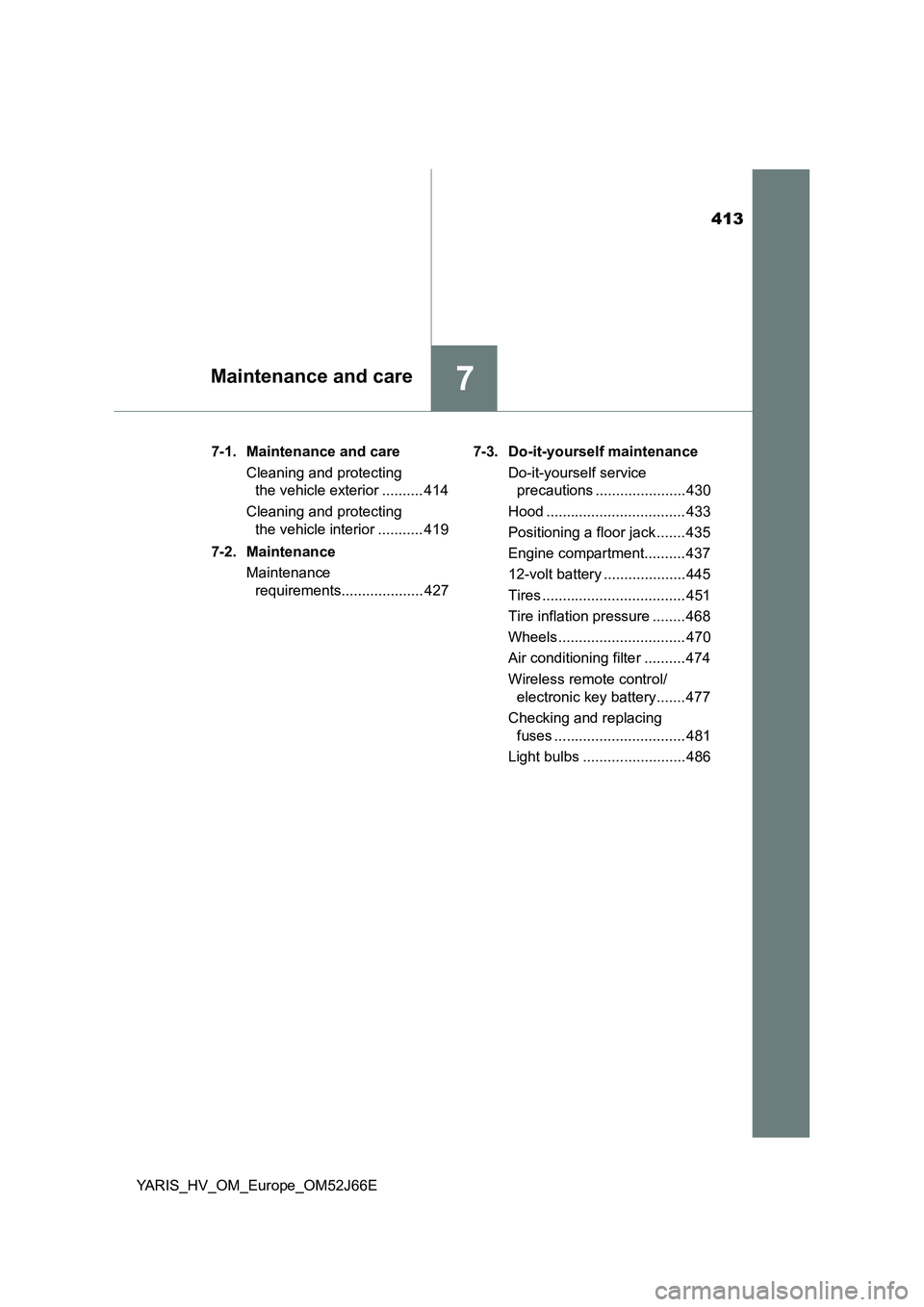
413
7Maintenance and care
YARIS_HV_OM_Europe_OM52J66E
7-1. Maintenance and care
Cleaning and protecting
the vehicle exterior .......... 414
Cleaning and protecting
the vehicle interior ........... 419
7-2. Maintenance
Maintenance
requirements.................... 427
7-3. Do-it-yourself maintenance
Do-it-yourself service
precautions ...................... 430
Hood .................................. 433
Positioning a floor jack ....... 435
Engine compartment.......... 437
12-volt battery .................... 445
Tires ................................... 451
Tire inflation pressure ........ 468
Wheels ............................... 470
Air conditioning filter .......... 474
Wireless remote control/
electronic key battery....... 477
Checking and replacing
fuses ................................ 481
Light bulbs ......................... 486
Page 430 of 632
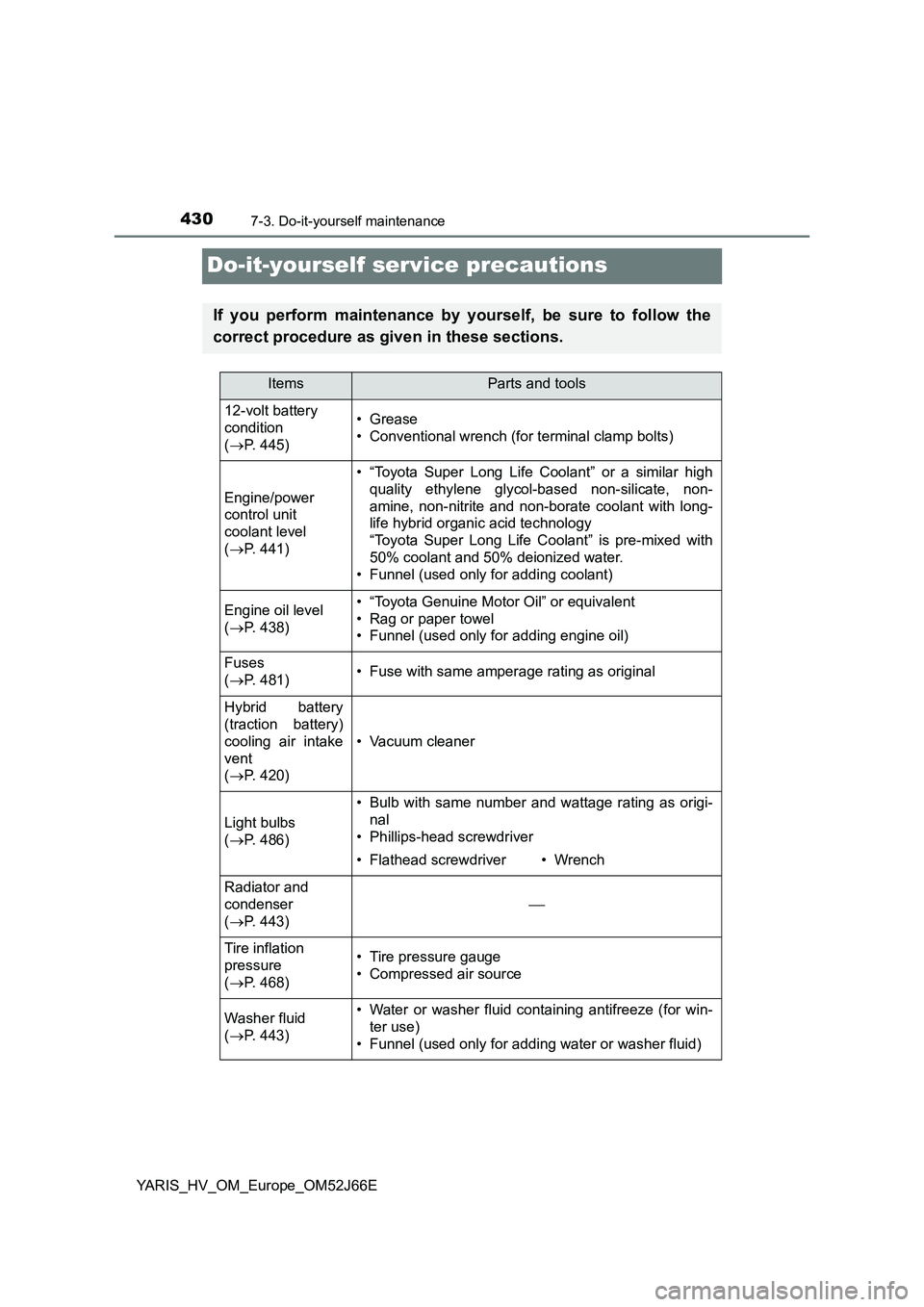
4307-3. Do-it-yourself maintenance
YARIS_HV_OM_Europe_OM52J66E
Do-it-yourself service precautions
If you perform maintenance by yourself, be sure to follow the
correct procedure as given in these sections.
ItemsParts and tools
12-volt battery
condition
( P. 445)
• Grease
• Conventional wrench (for terminal clamp bolts)
Engine/power
control unit
coolant level
( P. 441)
• “Toyota Super Long Life Coolant” or a similar high
quality ethylene glycol-based non-silicate, non-
amine, non-nitrite and non-borate coolant with long-
life hybrid organic acid technology
“Toyota Super Long Life Coolant” is pre-mixed with
50% coolant and 50% deionized water.
• Funnel (used only for adding coolant)
Engine oil level
( P. 438)
• “Toyota Genuine Motor Oil” or equivalent
• Rag or paper towel
• Funnel (used only for adding engine oil)
Fuses
( P. 481)• Fuse with same amperage rating as original
Hybrid battery
(traction battery)
cooling air intake
vent
( P. 420)
• Vacuum cleaner
Light bulbs
( P. 486)
• Bulb with same number and wattage rating as origi-
nal
• Phillips-head screwdriver
• Flathead screwdriver•Wrench
Radiator and
condenser
( P. 443)
Tire inflation
pressure
( P. 468)
• Tire pressure gauge
• Compressed air source
Washer fluid
( P. 443)
• Water or washer fluid containing antifreeze (for win-
ter use)
• Funnel (used only for adding water or washer fluid)
Page 452 of 632
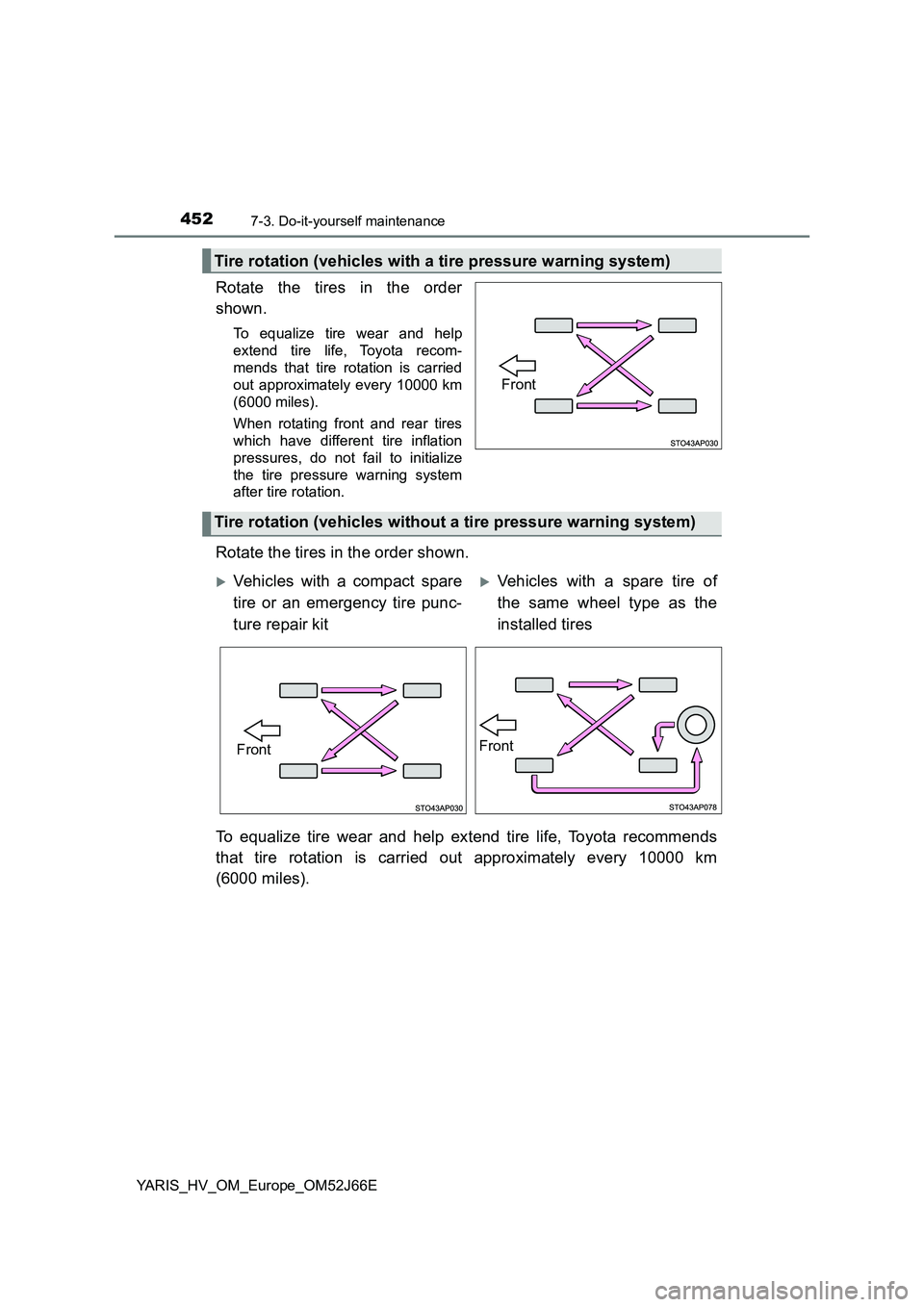
4527-3. Do-it-yourself maintenance
YARIS_HV_OM_Europe_OM52J66E
Rotate the tires in the order
shown.
To equalize tire wear and help
extend tire life, Toyota recom-
mends that tire rotation is carried
out approximately every 10000 km
(6000 miles).
When rotating front and rear tires
which have different tire inflation
pressures, do not fail to initialize
the tire pressure warning system
after tire rotation.
Rotate the tires in the order shown.
To equalize tire wear and help extend tire life, Toyota recommends
that tire rotation is carried out approximately every 10000 km
(6000 miles).
Tire rotation (vehicles with a tire pressure warning system)
Front
Tire rotation (vehicles without a tire pressure warning system)
Vehicles with a compact spare
tire or an emergency tire punc-
ture repair kit
Vehicles with a spare tire of
the same wheel type as the
installed tires
FrontFront
Page 453 of 632

4537-3. Do-it-yourself maintenance
7
Maintenance and care
YARIS_HV_OM_Europe_OM52J66E
Your vehicle is equipped with a tire pressure warning system that uses
tire pressure warning valves and transmitters to detect low tire infla-
tion pressure before serious problems arise.
If the tire pressure drops below a predetermined level, the driver is
warned by a warning light. ( P. 522)
◆Installing tire pressure warning valves and transmitters
When replacing tires or wheels, tire pressure warning valves and
transmitters must also be installed.
When new tire pressure warning valves and transmitters are installed,
new ID codes must be registered in the tire pressure warning com-
puter and the tire pressure warning system must be initialized. Have
tire pressure warning valve and transmitter ID codes registered by
any authorized Toyota retailer or Toyota authorized repairer, or any
reliable repairer. ( P. 455)
◆Initializing the tire pressure warning system
■The tire pressure warning system must be initialized in the fol-
lowing circumstances:
● When rotating front and rear tires which have different tire infla-
tion pressures
● When the tire inflation pressure is changed such as when chang-
ing traveling speed
● When changing the tire size
When the tire pressure warning system is initialized, the current tire
inflation pressure is set as the benchmark pressure.
Tire pressure warning system (if equipped)